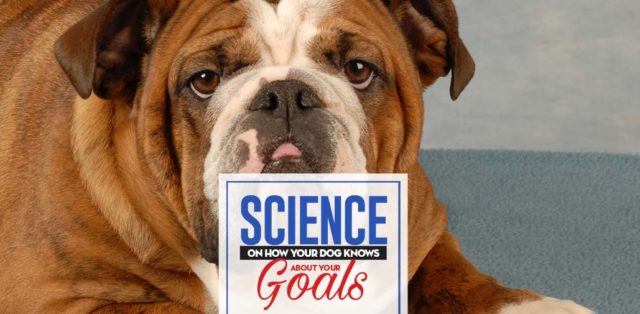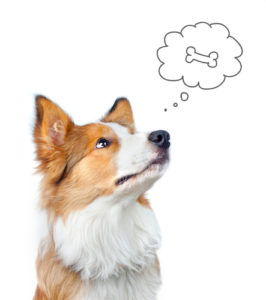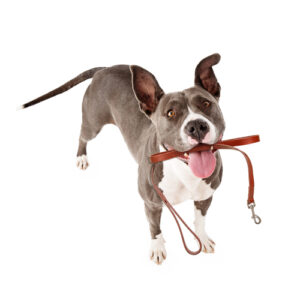
Table of Contents
Goals are an interesting concept, and they come in all shapes and sizes. From getting a job promotion, running a 5k, finding the right special someone, or even making a little extra time for ourselves on a Saturday morning. Goals are things we use to anchor our progress. And, when we meet them, we are able to say we did it.
Everyone has their own unique goals, and they change as you progress into different stages of your life. This is just as true for pet owners, but have you wondered if your dog has goals? And does he understand yours?
It’s safe to say that in our society, we are very goal oriented. We all have some kind of desire, dream, or objective to strive towards (Deci et al., 2000; PDF). While your dog probably doesn't share these exact same goals with you, there is a lot of interesting new research that suggests how dogs are more aware of our “goal orientedness” than we might think (Marshall-Pescini et al. 2014).
ALSO READ: The Science and Psychology of Dog Language – Does Your Dog Get You?
So, what’s Fido got to say about “goals”? Let's take a look at what we currently know.
Your Dog Knows About Your Goals
…and thinks they're not up to snuff
The ability to detect “goal orientedness” – if you want to call it that – boils down to what is known in cognitive science as intention attribution (Marshall-Pescini et al. 2014). Intention attribution is the ability to view others' actions as intentional. In other words, it is what allows us to interpret what others do according to how we evaluate our own decision-making process.
For example, when you see a co-worker not refill the coffee pot, one (generous) interpretation of why they did it comes from your own perspective: “Oh ya, I sometimes get so busy that I forget.”
Take this one step further, and you have what they call a theory of mind (Frith et al. 2005). Theory of mind is the ability we have to understand that we are not alone in this world (mentally speaking) and that others think similar thoughts to ours.
It’s that sense we have that other people are out there who experience life in a similar way to how we do.
Psychologists have shown that humans acquire a theory of mind early on, at a basic level, around four years of age (Frith et al. 2005). However, before we acquire the ability to conceive of other minds, we must first be aware that others' actions are goal-oriented.
So it goes goal oriented, intention attribution, then the theory of mind. If you got one, you can get the other. Moreover, these abilities build onto each other, like prerequisites to get into that higher math class you always wanted to take (Marshall-Pescini et al. 2014).
So, what does it mean to understand an action as goal-oriented, exactly? Well, it’s the feeling of awareness that there is some “reason” or “sentience” behind what the person (or animal) is doing.
 Take, for example, when we see an animal “steal” a piece of fruit from our apple tree. We interpret this as being goal directed: the animal wants to take the apple, so it can eat the apple. The reasons are many: to feed itself, or it’s young, so that it can satisfy its hunger, and so on (Marshall-Pescini et al. 2014).
Take, for example, when we see an animal “steal” a piece of fruit from our apple tree. We interpret this as being goal directed: the animal wants to take the apple, so it can eat the apple. The reasons are many: to feed itself, or it’s young, so that it can satisfy its hunger, and so on (Marshall-Pescini et al. 2014).
RELATED: The Science Behind Oxytocin and Puppy Love
Furthermore, as was mentioned before, these abilities are cumulative: this happens before we attribute intention to this action. We do not assume ill will from the animal stealing the fruit or that they conceive of it as stealing because we do not intuitively understand the moral codes under which animals operate (if there is such a thing).
We also don’t know if the animal believes (or not) that there are other minds like theirs out there (the third and final step, which only humans are believed to possess).
Bottom Line
So, the ability to attribute goal orientation to an action precedes the ability to attribute intention to an action. These abilities are prerequisites for having a theory of mind, or, the awareness that we have that we are not the only minds in the world.
In humans, studies have shown that the ability to perceive others' behavior as goal-oriented emerges a little before we are 1 year old (Aschersleben et al. 2008). So, as tots, we have the sense that mommy and daddy are up to something, but we are still blissfully ignorant that we aren’t the center of the universe.
Many primate species understand others' actions as goal-directed, yet this question has never been investigated in non primate species like dogs (Marshall-Pescini et al. 2014).
This is where the recent study by Marshall-Pescini, Ceretta, and PratoPrevide at the University of Portsmouth in collaboration with the Canis sapiens Lab at the University of Milan, which I've been referencing throughout the article, comes into play. They redirected this question towards dogs.

In the above pictures:
A) In the habituation phase dogs in the animate group saw the experimenter interacting repeatedly with one of two objects (in this case the globe). After a subject-determined number of trials to reach habituation, the dog was presented with…
B) 3 new-side trials (the experimenter interacted with the same object placed in the new location) followed by…
C) 3 repetitions of the new-goal trial (the experimenter interacted with the novel object, the watering-can here, placed in the old location).
Why would dogs be able to understand our actions as goal-directed, and why does it matter?
It’s really a matter of getting out of our own heads and into the heads of our companions. Empathy is one of humanity's greatest assets, but applying it, especially toward animal minds, is not only tricky but disorienting if you really think hard about it.
In other words, they wanted to turn the tables and, instead of projecting our minds onto dogs for a change – which is so overwhelmingly the case – see how dogs project their own minds onto us. The researchers had a hunch that because dogs have been so close to humans for the past 30,000 years or so, this may have resulted in what is known as convergent evolution (Marshall-Pescini et al. 2014).
Specifically, dogs converged onto more ‘human-like' social and cognitive skills that are found in people, which allowed them to become more attuned to us and thus better adapted to their new environment. Their goal was to answer the question: do dogs understand human actions as being goal-directed?
 Because dogs have lived with humans for such a long period of time, researchers believe that dogs have acquired abilities similar to humans and primates for understanding goal-oriented behavior.
Because dogs have lived with humans for such a long period of time, researchers believe that dogs have acquired abilities similar to humans and primates for understanding goal-oriented behavior.
Using the same methods that psychologists apply to understand infants' abilities, the researchers applied what is known as a habituation/dishabituation paradigm (Zelazo et al. 1984). Essentially, this measures how quickly the dog would get bored and lose interest in the objects that they were presented with. This is what they call the ‘habituation phase' (Marshall-Pescini et al. 2014).
The dishabituation phase is when the dogs are presented with new objects, according to the above two studies. Depending on whether the objects are paid more attention to or for a longer period of time, they are able to infer whether or not the dog was attributing a goalorientation toward humans.
So, in order to test this, the researchers used two groups of dogs.
The first group saw a person interact with the new (or novel) object, and the second group saw an inanimate object (a slightly menacing mechanical claw) interact with the new object.
The reason that they had these two groups is crucial for the experiment. Namely so that they could determine it was the dogs attributing a goal orientation towards humans. In other words, the researchers wanted to know if it was mere interaction with the object that made the dog look at it more or, specifically, interaction by people with the object.
They hypothesized that, just like infants, during the dishabituation phase, dogs would pay more attention to and spend more time looking at the object when a person interacted with it compared with when an inanimate object (such as a mechanical claw) did.
What they found with dogs was remarkably similar to human infants.In the last 3 habituation trials, the baby’s average looking time was 3.1 seconds, and for dogs, it was 2.9 seconds. During the dishabituation phase, the dogs looked at objects that were touched and moved by a human significantly longer than those that were acted upon by the inanimate object (in comparison to other animals, it was close to the amount seen in marmoset monkeys).
When the dogs were presented with novel objects, those that a human interacted with were looked at for an average of 6.5 seconds, whereas when they were interacted with by an inanimate object, they were looked at for only an average of about 4 seconds.

Bottom Line
These results confirmed the hypothesis put forth by the researchers. Dogs showed greater interest in the things that people handled versus what a mechanical claw did. The researchers were unable to reach any firm conclusions on how the dogs were able to do this.
We obviously can’t peer directly inside of the dog's mind. Studying infants who have not developed language yet and animals who communicate in different ways than us each offer peculiar difficulties in understanding how something is done. This is where our best logic and inference abilities come into play.
RELATED: Study Comparing Wolves and Dogs Explains Why Canines Are Our Best Friends
It stands to reason, and research supports the notion that animals have a mental life because of their unique creative problem-solving abilities. To give two simple examples, in an unknown situation at first, Kea birds are able to “pull the right strings” – literally – in order to access food (Deci et al. 2000), and dogs have been shown to be able to make simple inferences such as when locating food sources.
 However, much of animal (and even human behavior) is believed to consist of associations in the environment or the appearance of one thing preceding another. For example, when you pick up the leash and your dog zeros into ‘all walk mode,’ is this because they have thoughts about walking, or is it because they are reacting to a greater likelihood of walking when the leash is in your hand?
However, much of animal (and even human behavior) is believed to consist of associations in the environment or the appearance of one thing preceding another. For example, when you pick up the leash and your dog zeros into ‘all walk mode,’ is this because they have thoughts about walking, or is it because they are reacting to a greater likelihood of walking when the leash is in your hand?
The difference might seem tedious or downright trivial, but it is that kind of difference that we take as a sign of our elevated nature, our thinking ability, and the possibility we have to overcome our basic instinctual patterns. In any case, however much dogs have a mental life, like human infants and other primates, they have the same ability to perceive human goal-directed action.
While dogs may not be aware of other minds in the way humans are, this study gives strong evidence that they perceive our actions as goal-directed. Given how similar the results were to human infants and the newly discovered feasibility of this type of research as applied to dogs, this research represents a leap forward to further unravel how dogs are able to predict and relate to humans.
Before this study, it was unknown whether dogs could even be studied in the same way that infants are. Therefore, greater understanding and comparison between our two species will now be possible.
In Conclusion…
What seems clear is that dogs are keenly aware of how we interact with the world. That they are able to interpret our actions as being goal-directed represents an important insight into the mind of the dog, the only known animal outside of primates that is capable of making this kind of inference.
We would be wise to pay attention to our dogs as they wisely pay attention to us. Each of us has some kind of goal, some loftier than others. A new one for me is to empathize with my dog a little bit more and see what I can learn from her perspective on my own goals. See if she thinks they’re up to snuff.
READ NEXT: Science On Therapy Dogs for Depression – Fact or Fiction?
Want to share this?














